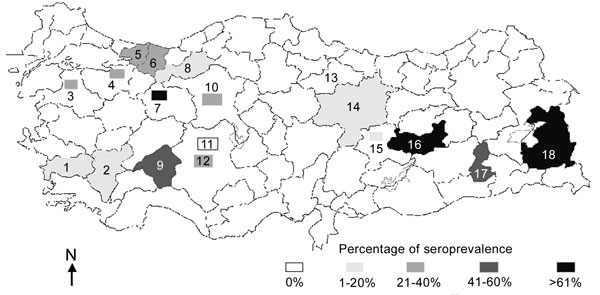Volume 8, Number 7—July 2002
Research
Prevalence, Distribution, and Host Range of Peste des petits ruminants virus, Turkey
Figure 1

Figure 1. Areas of Turkey sampled to detect the presence of infection with Peste des petits ruminants virus and Rinderpest virus. Numbers in parentheses indicate the number of serologic test materials collected from each location. Rectangles indicate a single outbreak; shaded provinces had multiple outbreaks. Key: 1, Aydin (100); 2, Denizli (164); 3, Balikesir (40); 4, Bursa (40); 5, Kocaeli (100); 6, Sakarya (100); 7, Eskisehir (5); 8, Bolu (160); 9, Isparta (100); 10, Ankara (20); 11, Cihanbeyli (75); 12, Konya (50); 13, Amasya (20); 14, Sivas (109); 15, Malatya (3); 16, Elazig (272); 17, Batman (50); 16, Van (199).
Page created: July 16, 2010
Page updated: July 16, 2010
Page reviewed: July 16, 2010
The conclusions, findings, and opinions expressed by authors contributing to this journal do not necessarily reflect the official position of the U.S. Department of Health and Human Services, the Public Health Service, the Centers for Disease Control and Prevention, or the authors' affiliated institutions. Use of trade names is for identification only and does not imply endorsement by any of the groups named above.